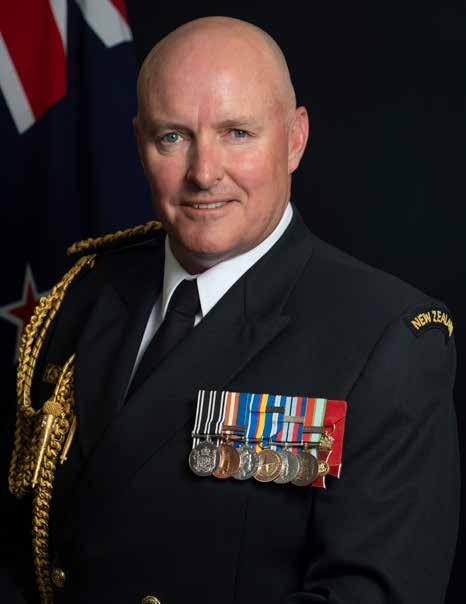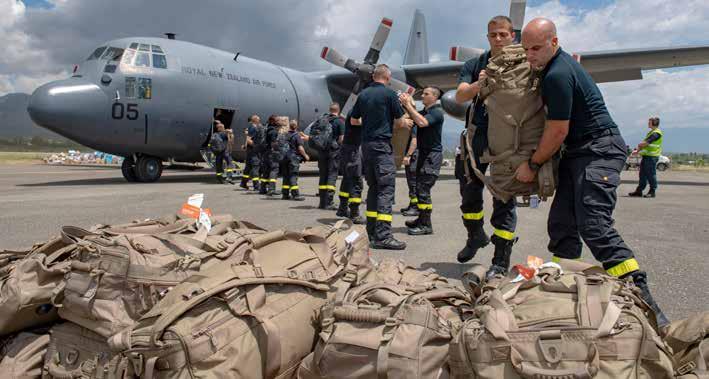
7 minute read
Towards the Networked Force: An interview with Commander Joint Forces New Zealand
Dr Peter Greener, Senior Fellow at the Centre for Strategic Studies (VUW) asks COMJ RADM James Gilmour about large-scale training exercises, overseas deployments, women in uniform, frigates, helicopters and more.
PG: From your perspective as Commander Joint Forces (COMJ), what are the main implications of the Strategic Defence Policy Statement 2018, and The Climate Crisis: Defence Readiness and Responsibilities 2018 report?
RADM Gilmour: Overall it’s pleasing to have refreshed direction from Government. The Strategic Defence Policy Statement (SDPS) makes clear the value that the NZDF offers to the Community, Nation and World. It reflects the Wellbeing Budget and the importance attached to ensuring the wellbeing of New Zealanders. The SDPS establishes the value NZDF brings.
In looking at the Living Standards Framework (LSF) and the Wellbeing Budget, the Capitals (Social, Human, Natural, and Financial and Physical) which form the foundation of the LSF necessarily rely on a sovereign, secure New Zealand. National security is therefore a critical element in achieving Government’s wellbeing outcomes. The SDPS sets out clearly the roles and capabilities required of the Defence Force and how we should be prepared to respond. We are required to be combat capable; flexible and agile; highly trained and competetent; properly resourced; embody New Zealand’s values, and be seen as trusted partners.
The Climate Crisis: Defence Readiness and Responsibilities 2018 report had no surprises in it. The report establishes the security-related threats of climate change and by implication the tasks the NZDF will need to be prepared for. The ongoing impact of climate change and extreme weather events, for example in Kiribati and Tuvalu, are illustrations of what we need to be ready to respond to.
PG: Over a fourteen-year period from 1999 until 2013, particularly with Timor Leste and Afghanistan, the New Zealand Defence Force experienced a very high tempo of operations with almost ten thousand personnel deployed to these operations. With current large deployments, Iraq and Antarctica for example, being alternately training focused or providing logistical support, how important are major exercises such as Sari Bair, Southern Katipo, Talisman Sabre and RIMPAC to ensuring combat interoperability with our partners and allies?
RADM Gilmour: We need to ensure that we maintain our ability to perform in medium to high intensity operations. Exercises such as these allow us to operate and integrate with partner militaries and improve interoperability. Our function at Joint Forces is to take capabilities prepared by the single Services and integrate them. We then use our experience to prepare capabilities rather than people.
PG: Whilst exercises such as Southern Katipo are central to the development of ensuring interoperability with our partners and allies, how important an exercise is it for the development of joint operations for the NZDF and for working with other government and partner agencies?
RADM Gilmour: Southern Katipo (SK) is the largest exercise run by the NZDF alongside other government agencies and NGOs. The focus since 2011 has been to realise the Joint Task Force – usually an amphibious Joint Task Force recognising our maritime environment. It provides the NZDF with an opportunity to ‘get everything out of the shed’ and achieve the Government’s Directed Level of Capability (DLOC) with mounting, projecting and sustaining a Joint Task Force.
Over the years we’ve achieved increasing complementarity - though conception, design, projection, sustainment and recovery will always need work. However, over the next five years the focus will be on the development of a truly networked combat force by 2025.
Networked means more than networked communications and command and control systems, it also means networked relationships. We are being very clear that Network to us is both a noun and a verb. So, it is not just about the equipment, it is what we do with it – it’s about attitude and imagination.
A truly networked force should be networked throughout the system rather than just in the battle space. How quickly can we communicate with the systems supporting us? How quickly can we clarify Rules of Engagement or get an airworthiness system decision to enable operations?

COMJFNZ RADM James Gilmour
Image: NZDF (supplied).
We are now working on SK20 and we need to question just how mature we are at being ‘networked’. Developing connections between Services and between agencies will be a major investment theme here.
PG: Although operational numbers in the Middle East have drawn down over the last six years, the NZDF still retains a significant presence in the area. Some deployments, such as those to the Multinational Force and Observers and to the United Nations Truce Supervision Organisation (UNTSO) have lasted for decades. What benefit do such deployments offer for New Zealand?
RADM Gilmour: The Government continues to commit to these missions because New Zealand values the rules-based order and here our actions match our rhetoric. Governments from both sides of the fence have reiterated our commitment in these areas. In return we gain important relationships and partners.
PG: In return, what benefits are NZDF personnel seen to bring to such missions?
RADM Gilmour: Without exception our people are well regarded. Often we are given responsibilities well above our rank level. We provide a capability which is respected, along with a cultural sensitivity which is valued. This isn’t an accidental capability – we are a bicultural, multi-cultural society which is part of a wider, diverse set of Pacific cultures. We are also a small first world nation and we know what it’s like to be condescended to; we identify other small nations and enter our relationships with them as partnerships.
PG: In considering NZDF personnel, despite significant efforts, the number of women in uniform in the NZDF has not significantly increased over the past decade. However academic research, both locally and internationally, demonstrates the value of deploying women in the field. As COMJ do you have any observations here?
RADM Gilmour: Women and men in the NZDF are highly capable and as a Commander I never draw distinctions in ability based on gender. There are though times when it is more appropriate from a cultural perspective for the NZDF to be represented by woman in uniform than men – when on operations engaging for instance with Moslem women.
Women commanders are every bit as effective as their male counterparts. I am frustrated by the slowness of growth in numbers of women in the ranks; it deprives us of talent. We need to work on perceived barriers to entry, and to exit.
We should encourage millennials to consider a career that will take them in and out of the NZDF. How can we create an employment system which recognises the skills people gain when they are in civilian employment, yet wish to return to their Service?
People ought to be able to gain promotion from recognition of the new skills they bring back to us. We need an environment that encourages this and I think we are making good progress in this area.
PG: Turning now to platform capability; each of the ANZAC frigates, Te Kaha and Te Mana, have been deployed several times on anti-terrorism and anti-piracy missions, for instance in the Arabian Gulf and off the Horn of Africa. You yourself were Commander, Combined Task Force 151, between July and October 2011 where you were responsible for counter piracy operations in the South Red Sea, Gulf of Aden and the Somali Basin. How important is it for New Zealand to have survivable ships to contribute to international peace and security operations?
RADM Gilmour: Survivability is key to operational effectiveness and the ability to persist. The ability to fight, win and survive will depend on threat, machinery, doctrine and training relative to the threat – whether the mission is in the Middle East or the Southern Ocean – nature itself is a threat to our people there. This extends to all equipment that the NZDF operates, not just the ships. A capability’s strengths and weaknesses will determine where it can be deployed and the outputs it can reasonably be expected to achieve.

PG: The Royal New Zealand Navy is in a process of fleet renewal and following the release of the Defence Capability Plan 2019, there will ultimately be nine ships capable of embarking helicopters, with the anticipated two sealift ships capable of carrying additional utility helicopters. At the same time there is to be an increase of more than 25% in Army service personnel. Whilst a commitment has been made in principal to replacing the maritime helicopters by 2028, should consideration be given not only to their replacement, but also to increasing the total number of operational helicopters?
RADM Gilmour: What is our Output Agreement with the Government and how many capabilities are required to achieve that? We have an economy roughly the size of Sydney’s and there’s a lot of competition for the public dollar. The Capital Plan spends some time looking at models of affordability and our current Capability Plan provides the best value for money. These considerations balance capability qualities and quantities. As an operational commander I am aware that quantity can have a quality of its own – it is not ideal to have the latest highest tech that is not available due to the small numbers of them that can be afforded.
PG: Returning to personnel, in the July issue of Navy Today the Chief of Navy indicated that whilst Navy will have a world-class fleet by 2030 “there will be a challenge in the personnel area.” An increase in the size of Army is to be welcomed, but given the additional capability the ships’ platforms may potentially bring, do you believe that there may need to be an increase overall in Navy personnel?
RADM Gilmour: Modelling would show that Navy needs more suitably qualified personnel; the Integrated Force Structure model will show that. Rather than absolute numbers we need to talk about effectiveness, and here Navy would argue that you need more personnel to achieve a suitable ship-to shore ratio.
PG: What do you see as the major challenges for ‘jointness’ in the NZDF for the future?
RADM Gilmour: The greatest challenge is moving from the ‘joint effect’ to the ‘networked effect’. Each of the single Services have their own training priorities but there’s rarely anything any Service does without support from another. To provide the joint effect requires us to be an integrated, networked force.
* Dr Peter Greener is a Senior Fellow at the Centre for Strategic Studies at Victoria University Wellington. He is also an Honorary Professor and was previously Academic Dean at the Command and Staff College of the New Zealand Defence Force.










